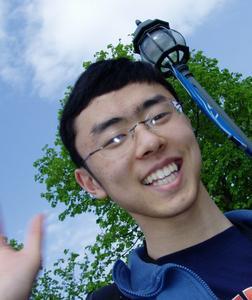Splash Biography
ANDREW GENG, UChicago grad student studying math
|
Major: Mathematics College/Employer: UChicago Year of Graduation: G |

|
Brief Biographical Sketch:
Andrew Geng likes to do math that involves drawing pretty pictures. He wishes he were better at drawing pretty pictures. In his spare time, he tries to write pretty music and pretends he knows how to cook. Past Classes(Clicking a class title will bring you to the course's section of the corresponding course catalog)S1299: Superbugs: Natural Selection in the Modern World in Splash Fall 2014 (Oct. 04, 2014)
Only a few years after a new kind of insecticide is introduced, resistant insects are found in the wild. Penicillin, an antibiotic which revolutionized medicine at its invention, is no longer effective against many kinds of bacteria. And in England there are rats which can survive five times the normal lethal dose of rat poison. How did this happen?
We're going to play a game that simulates this situation; and maybe by altering the rules, we can come upon strategies to beat--or at least hold back--the superbugs.
A1279: Write Your Own Silly Lyrics! in Droplet Spring 2014 (May. 03, 2014)
Have you ever wanted to write a song parody like Weird Al does? Of course you have! So bring in something to sing about, and let's make it happen! Along the way we'll pick up some tidbits about rhyme, meter, and singable words—which are of course applicable to much more than song parodies.
Ability to sing is not required.
M1167: String! in Splash! Fall 2013 (Oct. 05, 2013)
Can you untie a knot by tying another knot next to it and canceling them out the way you cancel opposites in math class?
Can you hang a picture on two nails in a wall so that the picture falls down if a single nail--no matter which one--is removed?
How could math possibly help with questions like these? And how could these possibly help with anything people actually do with string?
String will be provided. Bring your own questions too!
M1220: Idempotents: Forever Squared in Splash! Fall 2013 (Oct. 05, 2013)
$$6^2 = 3\boxed{6}$$
$$76^2 = 57\boxed{76}$$
$$376^2 = 141\boxed{376}$$
Can you find more numbers like this?
Is there a limit to how long they can get?
Can you find any which end in 5 instead?
Can you do this in base 2? Base 12?
In our quest to answer these questions, we’ll get a little glimpse of a kind of math known as "ring theory". (What does this silliness have to do with rings anyway?)
A1087: Demystifying Computers in Cascade! Fall 2012 (Oct. 23, 2012)
Our world is peppered with a bewildering array of computing devices that seem almost magical—from pocket calculators to smartphones to gaming consoles and beyond!
Have you ever wondered what goes on behind the scenes inside—or between!—these gadgets? How does a calculator arrive at its answer? Where do e-mails go when you click "Send"? What's so important about JPEG and MP3 files anyway? We'll explore those questions and more!
M1002: The Curiously Colorful Complex Plane in Splash! Fall 2012 (Oct. 06, 2012)
Once upon a time, mathematicians wondered if $$-1$$ deserves a square root. When they made one up, they found a two-dimensional family of other numbers—the "complex numbers"!
This makes graphing functions $$y=f(x)$$ somewhat difficult; if $$x$$ and $$y$$ can both be complex, we'll need four dimensions! Still, by using color (see the attached images), we can cope and maybe find strange shapes lurking in the complex world!
Pretty pictures will be included.
S1065: The Secret Life of Waves in Splash! Fall 2012 (Oct. 06, 2012)
A prism spreads light waves into a rainbow of colors. Can you do that with sound waves too?
Yes! Your ears do this all the time!
What else do light waves and sound waves have in common? (What kind of sound can move in a tight beam like a ray of light?) How are they like water waves? And what do MP3s and JPEGs have to do with all of this?
M835: Trigonometry With Pictures in Splash! Fall 2011 (Oct. 01, 2011)
Let's take trigonometry back to its roots! Sines and cosines measure side lengths of triangles, so let's see if we can explain the equations they satisfy by drawing some pictures.
In one hour we won't find everything you'd see in a high school trigonometry class, but hopefully by the end you'll have seen enough that you can find more on your own.
M836: The Magic of Wedge Products in Splash! Fall 2011 (Oct. 01, 2011)
Have you ever wondered how cross products would work in dimensions higher than 3? (How would, say, rotational motion work in 4 dimensions anyway?) Or why cross products can be calculated using what looks like a determinant?
Wedge products, a related way to multiply vectors, can illuminate these questions. The allowable vectors are a bit more complicated, but the rules are simple. Maybe it will help you remember how to calculate cross products too!
|
|
